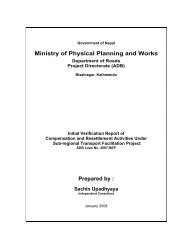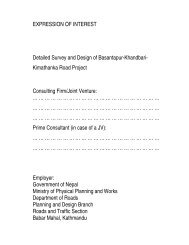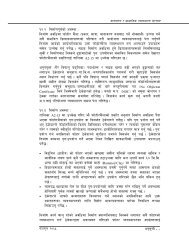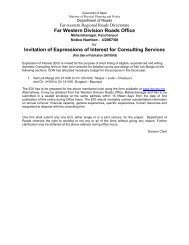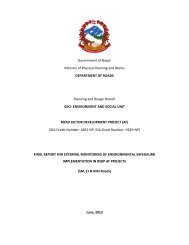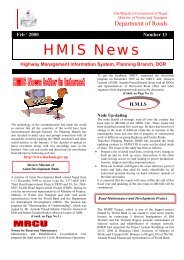Environmental & Social Management Framework - About ...
Environmental & Social Management Framework - About ...
Environmental & Social Management Framework - About ...
You also want an ePaper? Increase the reach of your titles
YUMPU automatically turns print PDFs into web optimized ePapers that Google loves.
<strong>Environmental</strong> and <strong>Social</strong> <strong>Management</strong> <strong>Framework</strong>Pollution. The Guideline suggests methods for determining how and when thepublic should be included in the environmental analysis.Apart from providing a comprehensive list for mitigation measures to beincorporated into DoR projects, it describes the procedures for publicparticipation, and other socio-economic safeguard considerations. It gives adviceon assessing socio-economic impacts and strategies for reducing or avoidingpotential adverse impacts, and for maximizing the positive ones for the benefit oflocal residents. The Socio-economic impacts include important issues of landacquisition and compensation and other economic impacts related with marketsfor agriculture production, agriculture inputs, nutrition, extraction of naturalresources beyond replenishment, migration and influx of migrants, landspeculation, illegal logging and mining, carrying goods by porters etc. It alsoincludes the handling of impacts on cultural heritage.3.6.3 Reference Manual for <strong>Environmental</strong> and <strong>Social</strong> Aspects of IntegratedRoad Development, MPPW/DoR, 2003This Manual is designed to help integrate social and environmentalconsiderations, including public involvement strategies, with technical roadconstruction practices. It suggests stepwise process of addressing E&S issuesalongside the technical, financial and others. The Manual is a suggestive, and notexhaustive, and advise and recommends various environmental and socialapproaches, actions and strategies to assist developers in following mandatoryrequirements of the law and improving public involvement. The Manual is basedon the experiences of Nepal, as well as incorporates the national (EPA, 1996;EPR, 1997/1999) and international ‘best practices’. It suggests process ofenvironmental and social assessment process, roles and responsibilities ofstakeholders at various stages of the project, advice on impact mitigation actionplans, and process for involving the public.3.6.4 The National Transport Policy, 2001This policy states, among others, that the entire process of land acquisition andtransferring of land ownership to the project shall be established prior to thecommencement of road project implementation. Equally, a basis for livelihoodshall be established to the fully displaced families by way of rehabilitation or byany other means.3.6.5 Land Infrastructure Development Policy 2004Includes the provisions related to the requirement of advance acquisition of landfor major transport sector projects, bearing long-term consequences on thedevelopment of the nation.3.6.6 Public Infrastructure Built and Operate Policy, (2000)States that the GoN may acquire the necessary land and provide it to theconcessionaire as per prevailing rules but the cost shall be born by the privatesector.3.7 GoN Policies Supporting Vulnerable CommunitiesIn all regions where roads are to be newly built or upgraded under the SRNProgram, there is high incidence of poverty and vulnerable groups. Accordingly,all Project Designs shall give sufficient consideration, based on current policiesand good practices, to develop strategies while addressing uplift of livelihoods ofthese groups. Nepal does not have a standalone policy on Indigenous Peoples,However in the Tenth Plan significant emphasis has been placed on deliveringApril 2007 Chapter 3-13



![j:6 ]zg cfof ]hgf](https://img.yumpu.com/51286794/1/190x245/j6-zg-cfof-hgf.jpg?quality=85)

![x'nfsL /fhdfu { cfof ]hgf](https://img.yumpu.com/50581959/1/190x245/xnfsl-fhdfu-cfof-hgf.jpg?quality=85)
